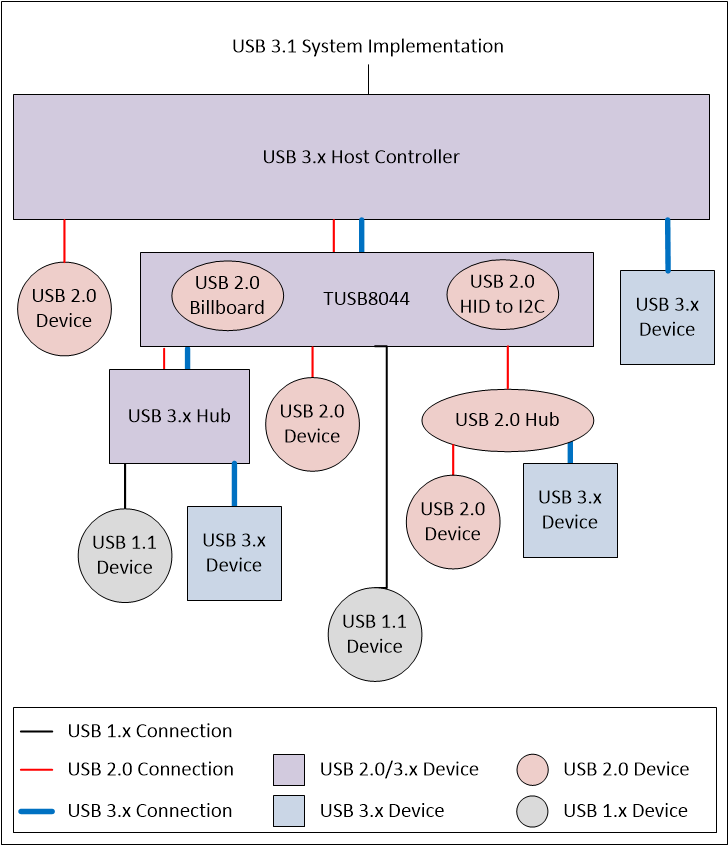SLLSEW5 April 2017 TUSB8044
PRODUCTION DATA.
- 1 Features
- 2 Applications
- 3 Description
- 4 Revision History
- 5 Description (Continued)
- 6 Pin Configuration and Functions
- 7 Specifications
-
8 Detailed Description
- 8.1 Overview
- 8.2 Functional Block Diagram
- 8.3
Feature Description
- 8.3.1 Battery Charging Features
- 8.3.2 USB Power Management
- 8.3.3 I2C Programming Support Using Internal Hid to I2C Interface
- 8.3.4 USB2.0 Billboard
- 8.3.5 One Time Programmable (OTP) Configuration
- 8.3.6 Clock Generation
- 8.3.7 Crystal Requirements
- 8.3.8 Input Clock Requirements
- 8.3.9 Power-Up and Reset
- 8.4 Device Functional Modes
- 8.5
Register Maps
- 8.5.1 Configuration Registers
- 8.5.2 ROM Signature Register
- 8.5.3 Vendor ID LSB Register
- 8.5.4 Vendor ID MSB Register
- 8.5.5 Product ID LSB Register
- 8.5.6 Product ID MSB Register
- 8.5.7 Device Configuration Register
- 8.5.8 Battery Charging Support Register
- 8.5.9 Device Removable Configuration Register
- 8.5.10 Port Used Configuration Register
- 8.5.11 Device Configuration Register 2
- 8.5.12 USB 2.0 Port Polarity Control Register
- 8.5.13 UUID Registers
- 8.5.14 Language ID LSB Register
- 8.5.15 Language ID MSB Register
- 8.5.16 Serial Number String Length Register
- 8.5.17 Manufacturer String Length Register
- 8.5.18 Product String Length Register
- 8.5.19 Device Configuration Register 3
- 8.5.20 USB 2.0 Only Port Register
- 8.5.21 Billboard SVID LSB
- 8.5.22 Billboard SVID MSB
- 8.5.23 Billboard PID LSB
- 8.5.24 Billboard PID MSB
- 8.5.25 Billboard Configuration
- 8.5.26 Billboard String1 Length
- 8.5.27 Billboard String2 Length
- 8.5.28 Serial Number String Registers
- 8.5.29 Manufacturer String Registers
- 8.5.30 Product String Registers
- 8.5.31 Additional Feature Configuration Register
- 8.5.32 SMBus Device Status and Command Register
- 8.5.33 Billboard String1_2
-
9 Applications and Implementation
- 9.1 Application Information
- 9.2
Typical Application
- 9.2.1
Discrete USB Hub Product
- 9.2.1.1 Design Requirements
- 9.2.1.2
Detailed Design Procedure
- 9.2.1.2.1 Upstream Port Implementation
- 9.2.1.2.2 Downstream Port 1 Implementation
- 9.2.1.2.3 Downstream Port 2 Implementation
- 9.2.1.2.4 Downstream Port 3 Implementation
- 9.2.1.2.5 Downstream Port 4 Implementation
- 9.2.1.2.6 VBUS Power Switch Implementation
- 9.2.1.2.7 PD Controller and EEPROM Implementation
- 9.2.1.2.8 DisplayPort Implementation
- 9.2.1.2.9 Clock, Reset, and Misc
- 9.2.1.2.10 TUSB8044 Power Implementation
- 9.2.1.3 Application Curves
- 9.2.1
Discrete USB Hub Product
- 10Power Supply Recommendations
- 11Layout
- 12Device and Documentation Support
- 13Mechanical, Packaging, and Orderable Information
Package Options
Refer to the PDF data sheet for device specific package drawings
Mechanical Data (Package|Pins)
- RGC|64
Thermal pad, mechanical data (Package|Pins)
Orderable Information
1 Features
- Four Port USB 3.1 Gen1 Hub
- USB 2.0 Hub Features
- Multi Transaction Translator (MTT) Hub: Four Transaction Translators
- Two Asynchronous Endpoint Buffers Per Transaction Translator
- Supports Battery Charging:
- Supports D+/D- Divider Charging Port (ACP1, ACP2, and ACP3) when the Upstream Port is Unconnected or not Configured
- Supports Automatic Mode for Transition Between DCP or ACP Modes When the Upstream Port is Unconnected
- Supports Galaxy Charging
- CDP Mode (Upstream Port Connected)
- DCP Mode (Upstream Port Unconnected)
- DCP Mode Complies with Chinese Telecommunications Industry Standard YD/T 1591-2009
- Supports Operation as a USB 3.1 Gen1 or USB 2.0 Compound Device
- Supports USB Billboard
- Per Port or Ganged Power Switching and Over-Current Notification Inputs
- Supports Four External Downstream Ports plus internal USB 2.0-Only Ports for USB HID to I2C Functionality and USB2.0 Billboard
- Internal Downstream Port for I2C Control Through USB HID Supports High-Speed, Full-Speed Operation. Its Speed Matches That of the Upstream Port.
- Supports Vendor Requests to Read and Write I2C and EEPROM Read at 100 k and 400 k (Default)
- I2C Master Supports Clock Stretching
- OTP ROM, Serial EEPROM or I2C/SMBus Slave Interface for Custom Configurations:
- VID and PID
- Port Customizations
- Manufacturer and Product Strings (not by OTP ROM)
- Serial Number (not by OTP ROM)
- Provides 128-Bit Universally Unique Identifier (UUID)
- Supports On-Board and In-System EEPROM Programming Via the USB 2.0 Upstream Port
- Single Clock Input, 24-MHz Crystal or Oscillator
- Downstream Ports Configurable to USB2.0 Only
- 64-Pin QFN Package (RGC)
2 Applications
Computer Systems, Docking Stations, Monitors, Set-Top Boxes
3 Description
The TUSB8044 is a four-port USB 3.1 Gen1 hub. It provides simultaneous SuperSpeed USB and high-speed/full-speed connections on the upstream port and provides SuperSpeed USB, high-speed, full-speed, or low-speed connections on the downstream ports. When the upstream port is connected to an electrical environment that only supports high-speed or full-speed/low-speed connections, SuperSpeed USB connectivity is disabled on the downstream ports.
Device Information(1)
| PART NUMBER | PACKAGE | BODY SIZE (NOM) |
|---|---|---|
| TUSB8044 | VQFN (64) | 9.00 mm × 9.00 mm |
- For all available packages, see the orderable addendum at the end of the datasheet.
Diagram

4 Revision History
| DATE | REVISION | NOTES |
|---|---|---|
| April 2017 | * | Preliminary release. |